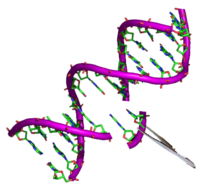
Photo from wikipedia
The identification of useful biological indicators to monitor the body response before the presentation of clinical diseases has practical value in livestock production. To identify potential biomarkers in pigs at… Click to show full abstract
The identification of useful biological indicators to monitor the body response before the presentation of clinical diseases has practical value in livestock production. To identify potential biomarkers in pigs at the early stage during inflammation, 12 pigs were intramuscularly injected with 2mL of Lipopolysaccharide (LPS, 15μg/kg BW) or saline. Serum protein expression profiles were detected with two-dimensional electrophoresis (2-DE) and matrix-assisted laser desorption ionization time of flight mass spectrometry (MALDI-TOF-MS) techniques. Serum biochemical indicators and acute phase protein (APP) concentrations were analyzed with an automatic biochemical analyzer and ELISA, respectively. Of the serum biochemical indicators, creatinine concentration significantly increased 6h post infection, whereas albumin showed a decreased tendency. The 2-DE and MALDI-TOF mass spectrometry technique detected 17 protein spots representing 10 proteins: α-1-antichymotrypsin, albumin, bovine lactoferrin, serotransferrin, serpin A3-6, immunoglobulin light chain (κ chain, mu chain), complement C3 precursor, zinc-α-2-glycoprotein (ZAG), and ceruloplasmin. Two proteins were selected to confirm the mass spectrometry results, and resulting differences accorded with the proteomics results. Of the four typical acute phase protein (APPs) measured, the C-reactive protein (CRP) and haptoglobin (HP) concentrations increased significantly, while no differences were observed in the pig-major acute phase protein (Pig-MAP) and transthyretin (TTR) contents. The results showed that serum creatinine, CRP, HP, and ten other proteins content changed significantly after LPS injection. Of these proteins, ZAG was first reported in pigs during inflammation. These proteins show great promise as biomarkers to monitor the health status and welfare of pigs during the early stage of LPS-induced inflammation.
Journal Title: Research in veterinary science
Year Published: 2017
Link to full text (if available)
Share on Social Media: Sign Up to like & get
recommendations!